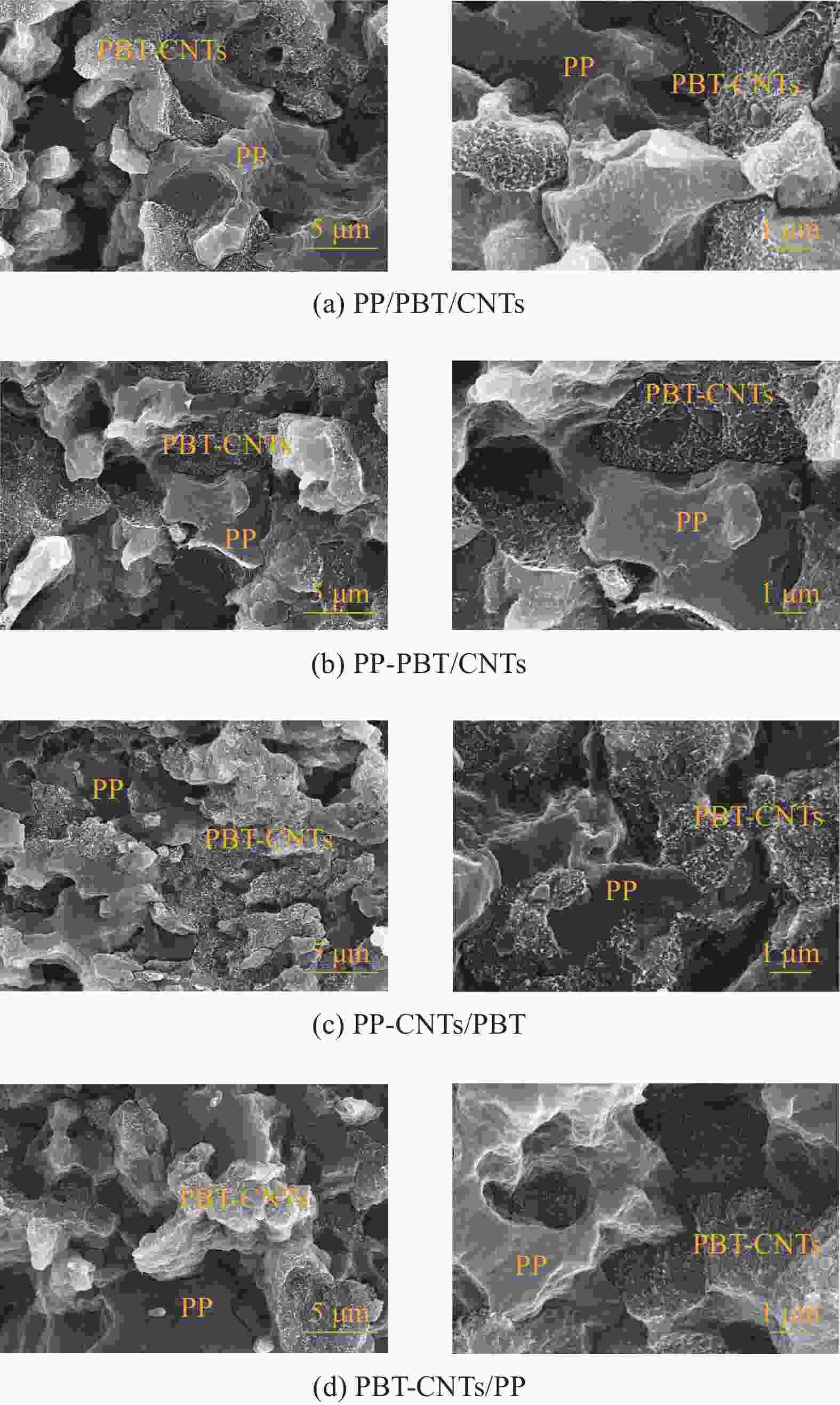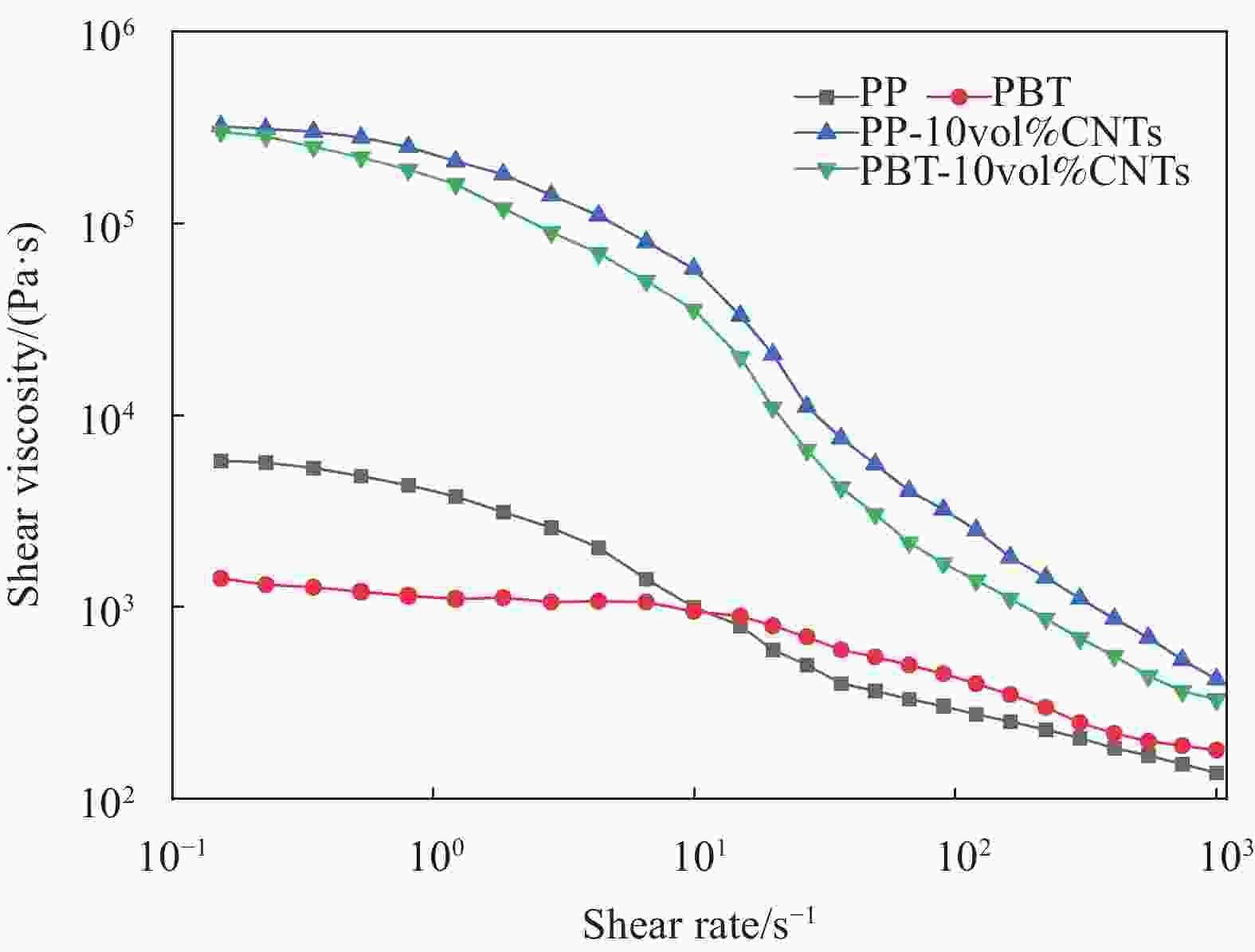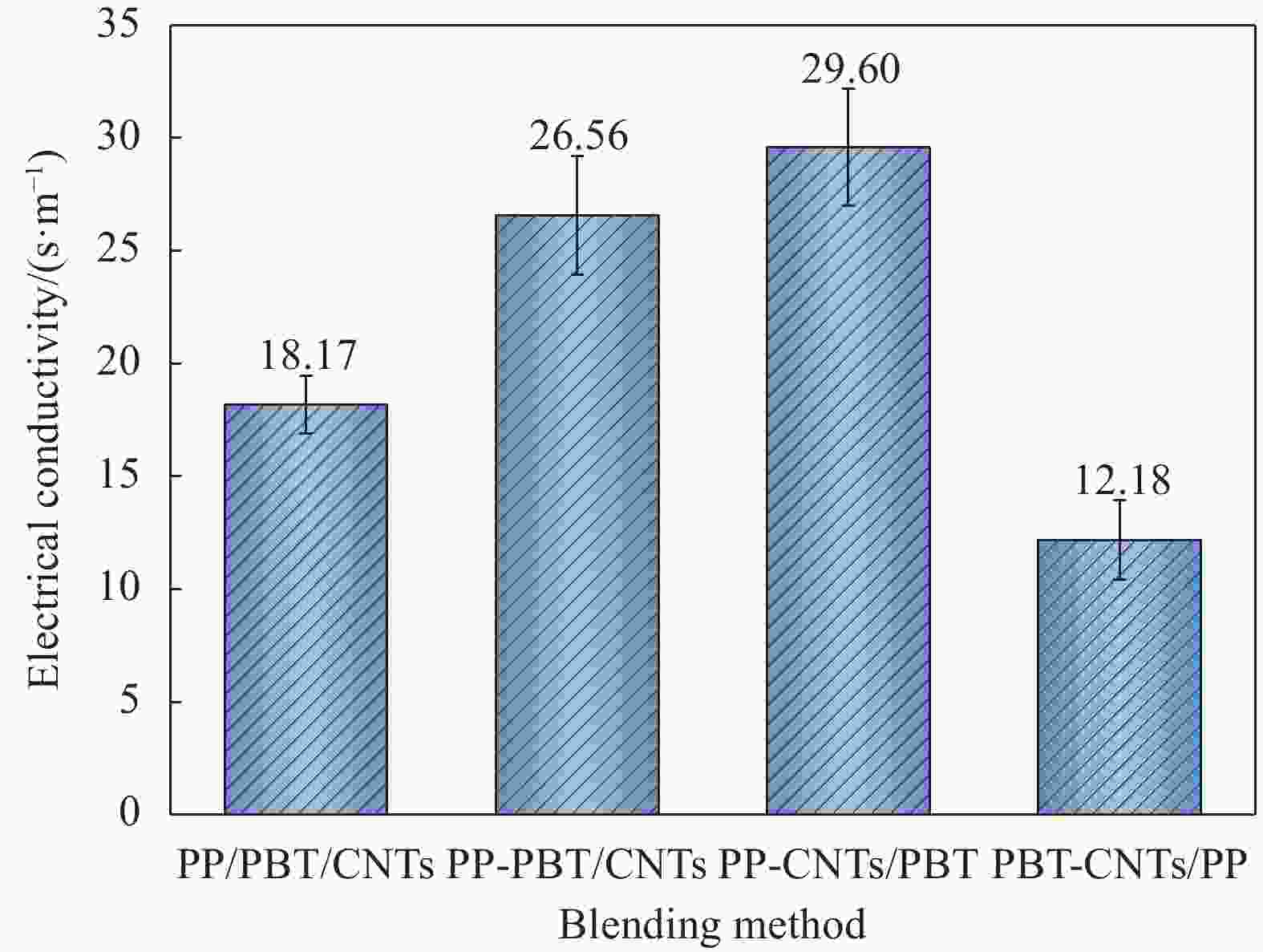Preparation and properties of micromodulation-based polypropylene/polybutylene terephthalate/carbon nanotube electromagnetic shielding materials
-
摘要: 电子设备对外界环境造成的电磁污染已经成为继噪声污染、大气污染、水污染、固体废物污染之后的又一大公害,因此高性能电磁屏蔽材料的研制与开发已经成为现今材料科学研究的热点。本文通过调整聚丙烯(PP)、聚对苯二甲酸丁二酯(PBT)、碳纳米管(CNTs)在熔融共混过程中的共混方式,借助CNTs对PBT的定向迁移行为调控PP/PBT/CNTs共混物中聚合物相的相畴尺寸。通过形貌分析、动态流变和结晶行为测试,研究了复合材料微观形貌对其电磁屏蔽特性的影响。研究结果表明,相比于PP相,CNTs对PBT相的亲和作用更强,在四种共混方式中始终位于PBT相畴内;当采用PP/CNTs母料法制备PP/PBT/CNTs复合材料时,所得到的复合材料内部PBT的相畴尺寸更小,PP和PBT间的相容性更高,此时导电通路和界面面积都显著增加,复合材料内部形成了更加密集均匀的导电网络结构,因此所制备的聚合物基复合材料的电导率显著提升,达到29.60 s/m,电磁屏蔽效能在X波段(8.2-12.4 GHz)达到35.6 dB,远超过商业电磁屏蔽材料的需求。Abstract: The electromagnetic pollution caused by electronic equipment to the external environment has become another major public hazard after noise pollution, air pollution, water pollution and solid waste pollution, so the research and development of high-performance electromagnetic shielding materials has become a hot spot in materials science research. In this paper, the phase domain size of the polymer phases in the PP/PBT/CNTs blends was regulated by adjusting the blending methods of polypropylene (PP), polybutylene terephthalate (PBT) and carbon nanotubes (CNTs) during the melt blending process. The influence of the microscopic morphology of the composites on their electromagnetic shielding properties was studied by morphology analysis, dynamic rheology and crystallization behavior tests. The results show that compared with the PP phase, CNTs have a stronger affinity for the PBT phase, and are always located in the PBT phase domain among the four blending methods. When the PP/PBT/CNTs composites are prepared by PP/CNTs masterbatch method, the phase domain size of the PBT inside the obtained composites is smaller, the compatibility between PP and PBT is higher, the conductive path and interface area are significantly increased, and a denser and uniform conductive network structure is formed inside the composites, so the conductivity of the prepared polymer matrix composites is significantly improved, reaching 29.60 s/m, and the electromagnetic shielding efficiency is in the X-band (8.2-12.4 GHz) to 35.6 dB, far exceeding the demand for commercial electromagnetic shielding materials.
-
Key words:
- Polymer /
- Carbon nanotubes /
- Blending method /
- Microscopic topography /
- Electromagnetic shielding
-
表 1 样品名称及共混方式
Table 1. Sample names and blending methods
Sample code Blending method PP/PBT/CNTs One-step method 12 min PP-PBT/CNTs ①PP+PBT 3 min ②PP-PBT+CNTs 12 min PP-CNTs/PBT ①PP+CNTs 12 min ②PP-CNTs+PBT 3 min PBT-CNTs/PP ① PBT+CNTs 12 min ②PBT-CNTs+PP 3 min Notes: PP—polypropylene; PBT—polybutylene terephthalate; CNTs—carbon nanotubes 表 2 各组分表面张力值
Table 2. Surface tension values of each component
Sample Surface tension/mJ·m−2 $\gamma $ ${\gamma ^d}$ ${\gamma ^p}$ PP 22.3 14.2 8.1 PBT 24.1 16.4 7.7 CNTs[27] 27.8 17.6 10.2 Notes: $\gamma $—Surface energy; ${\gamma ^d}$—Dispersive surface energy; ${\gamma ^p}$—Polar surface energy. -
[1] CAO M, CAI Y Z, HE P, et al. 2D MXenes: electromagnetic property for microwave absorption and electromagnetic interference shielding[J]. Chemical Engineering Journal, 2019, 359: 1265-1302. doi: 10.1016/j.cej.2018.11.051 [2] LIANG C, LIU Y, RUAN Y, et al. Multifunctional sponges with flexible motion sensing and outstanding thermal insulation for superior electromagnetic interference shielding[J]. Composites Part A:Applied Science and Manufacturing, 2020, 139: 106143. doi: 10.1016/j.compositesa.2020.106143 [3] 张梦辉, 马忠雷, 马建中, 等. 聚合物基电磁屏蔽复合材料的结构设计与性能研究进展[J]. 复合材料学报, 2021, 38(5): 1358-1370.ZHANG MengHui, MA ZhongLei, MA JianZhong, et al. Research progress on structural design and properties of polymer-based electromagnetic shielding composites[J]. Journal of Composite Materials, 2021, 38(5): 1358-1370(in Chinese). [4] 王喜花, 刘涛, 黄丽, 等. 静电纺丝技术制备复合纳米纤维电磁屏蔽及吸波材料的研究进展[J]. 复合材料学报, 2023, 40(3): 1300-1310.WANG XiHua, LIU Tao, HUANG Li, et al. Research progress on the preparation of composite nanofiber electromagnetic shielding and absorbing materials by electrospinning technology[J]. Journal of Composite Materials, 2023, 40(3): 1300-1310(in Chinese). [5] SINGH A K, SHISHKIN A, KOPPEL T, et al. A review of porous lightweight composite materials for electromagnetic interference shielding[J]. Composites Part B:Engineering, 2018, 149: 188-197. doi: 10.1016/j.compositesb.2018.05.027 [6] WANG Y, LIU S, ZHU H, et al. The entangled conductive structure of CB/PA6/PP MFCs and their electromechanical properties[J]. Polymers, 2021, 13(6): 961. doi: 10.3390/polym13060961 [7] LI J, CHEN J L, TANG X H, et al. Constructing nanopores in poly (oxymethylene)/multi-wall carbon nanotube nanocomposites via poly (l-lactide) assisting for improving electromagnetic interference shielding[J]. Journal of colloid and interface science, 2020, 565: 536-545. doi: 10.1016/j.jcis.2020.01.057 [8] GAO Z, DONG Q, SHANG M, et al. Microstructure and properties of poly (butylene terephthalate)/poly (ethylene terephthalate) composites based on carbon nanotube s/graphene nanoplatelet s hybrid filler systems[J]. Journal of Applied Polymer Science, 2022, 139(9): 51733. doi: 10.1002/app.51733 [9] MARKHAM D. Shielding: quantifying the shielding requirements for portable electronic design and providing new solutions by using a combination of materials and design[J]. Materials & Design, 1999, 21(1): 45-50. [10] ZENG Z, CHEN M, JIN H, et al. Thin and flexible multi-walled carbon nanotube/waterborne polyurethane composites with high-performance electromagnetic interference shielding[J]. Carbon, 2016, 96: 768-777. doi: 10.1016/j.carbon.2015.10.004 [11] JASNA M, PUSHKARAN N K, MANOJ M, et al. Facile preparation of lightweight and flexible PVA/PEDOT: PSS/MWCNT ternary composite for high-performance EMI shielding in the X-band through absorption mechanism[J]. Journal of Electronic Materials, 2020, 49: 1689-1701. doi: 10.1007/s11664-019-07676-8 [12] HSIAO S T, MA C C M, TIEN H W, et al. Using a non-covalent modification to prepare a high electromagnetic interference shielding performance graphene nanosheet/water-borne polyurethane composite[J]. Carbon, 2013, 60: 57-66. doi: 10.1016/j.carbon.2013.03.056 [13] HSIAO S T, MA C C M, TIEN H W, et al. Effect of covalent modification of graphene nanosheets on the electrical property and electromagnetic interference shielding performance of a water-borne polyurethane composite[J]. ACS applied materials & interfaces, 2015, 7(4): 2817-2826. [14] SULTANA S M N, PAWAR S P, SUNDARARAJ U. Effect of processing techniques on EMI SE of immiscible PS/PMMA blends containing MWCNT: Enhanced intertube and interphase scattering[J]. Industrial & Engineering Chemistry Research, 2019, 58(26): 11576-11584. [15] TAO J R, YANG D, YANG Y, et al. Migration mechanism of carbon nanotubes and matching viscosity-dependent morphology in Co-continuous Poly (lactic acid)/Poly (ε-caprolactone) blend: Towards electromagnetic shielding enhancement[J]. Polymer, 2022, 252: 124963. doi: 10.1016/j.polymer.2022.124963 [16] HE L, SHI Y, WANG Q, et al. Strategy for constructing electromagnetic interference shielding and flame retarding synergistic network in poly (butylene succinate) and thermoplastic polyurethane multilayered composites[J]. Composites Science and Technology, 2020, 199: 108324. doi: 10.1016/j.compscitech.2020.108324 [17] CHEN J, LIAO X, LI S, et al. A promising strategy for efficient electromagnetic interference shielding by designing a porous double-percolated structure in MWCNT/polymer-based composites[J]. Composites Part A:Applied Science and Manufacturing, 2020, 138: 106059. doi: 10.1016/j.compositesa.2020.106059 [18] 邱健, 姜治伟, 邢海平, 等. 具有隔离结构的聚丙烯/碳纳米管复合材料的制备及电磁屏蔽性能[J]. 应用化学, 2020, 40(8): 904-911. doi: 10.11944/j.issn.1000-0518.2020.08.200083QIU Jian, JIANG ZhiWei, XING HaiPing, et al. Preparation and electromagnetic shielding properties of polypropylene/carbon nanotube composites with isolation structure[J]. Applied Chemistry, 2020, 40(8): 904-911(in Chinese). doi: 10.11944/j.issn.1000-0518.2020.08.200083 [19] SUMITA M, SAKATA K, ASAI S, et al. Dispersion of fillers and the electrical conductivity of polymer blends filled with carbon black[J]. Polymer bulletin, 1991, 25: 265-271. doi: 10.1007/BF00310802 [20] GUO J, BRIGGS N, CROSSLEY S, et al. Morphology of polystyrene/poly (methyl methacrylate) blends: effects of carbon nanotubes aspect ratio and surface modification[J]. AIChE Journal, 2015, 61(10): 3500-3510. doi: 10.1002/aic.14943 [21] CHEN G, LI P, HUANG Y, et al. Hybrid nanoparticles with different surface chemistries show higher efficiency in compatibilizing immiscible polymer blends[J]. Composites science and technology, 2014, 105: 37-43. doi: 10.1016/j.compscitech.2014.09.013 [22] 李果, 谢林生, 罗日萍, 等. 叠片式密炼机转子结构对混合特性的影响[J]. 高分子材料科学与工程, 2014, 30(3): 134-138.LI Guo, XIE LinSheng, LUO RiPing, et al. Effect of rotor structure on mixing characteristics of laminated mixer[J]. Polymer Materials Science and Engineering, 2014, 30(3): 134-138(in Chinese). [23] SERAJI A A, BAJGHOLI A A. Dual role of nanoclay in the improvement of the in-situ nanofibrillar morphology in polypropylene/polybutylene terephthalate nanocomposites[J]. Journal of Industrial Textiles, 2022, 52: 15280837221133570. [24] ZHANG L Q, YANG B, TENG J, et al. Tunable electromagnetic interference shielding effectiveness via multilayer assembly of regenerated cellulose as a supporting substrate and carbon nanotubes/polymer as a functional layer[J]. Journal of Materials Chemistry C, 2017, 5(12): 3130-3138. doi: 10.1039/C6TC05516H [25] OWENS D K, WENDT R C. Estimation of the surface free energy of polymers[J]. Journal of applied polymer science, 1969, 13(8): 1741-1747. doi: 10.1002/app.1969.070130815 [26] GUGGENHEIM E A. The principle of corresponding states[J]. The Journal of Chemical Physics, 1945, 13(7): 253-261. doi: 10.1063/1.1724033 [27] CARDINAUD R, MCNALLY T. Localization of MWCNTs in PET/LDPE blends[J]. European polymer journal, 2013, 49(6): 1287-1297. doi: 10.1016/j.eurpolymj.2013.01.007 [28] SHANG M, GAO Z, CHENG H, et al. Relationship between microstructure evolution and properties enhancement of carbon nanotubes-filled polybutylene terephthalate/polypropylene blends induced by thermal annealing[J]. Journal of Applied Polymer Science, 2022, 139(8): 51689. doi: 10.1002/app.51689 [29] 陶瑞祥, 高珠怡, 尚梦瑶, 等. 聚合物基电磁屏蔽复合材料结构调控研究进展[J]. 工程塑料应用, 2021, 49(06): 165-174 .TAO RuiXiang, GAO ZhuYi, SHANG MengYao, et al. Research progress on structural regulation of polymer-based electromagnetic shielding composites[J]. Engineering plastics applications, 2021, 49(06): 165-174 (in Chinese). -

 点击查看大图
点击查看大图
计量
- 文章访问数: 49
- HTML全文浏览量: 33
- 被引次数: 0





 下载:
下载:










